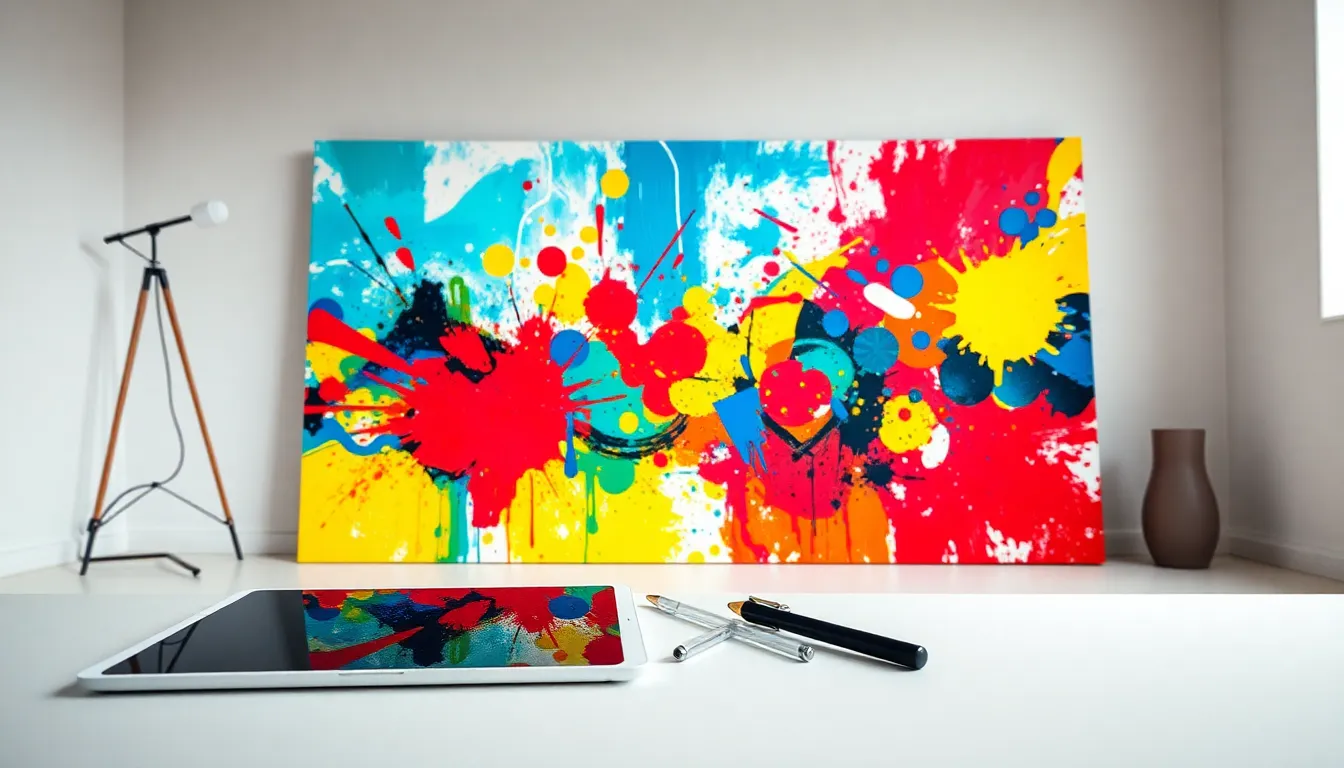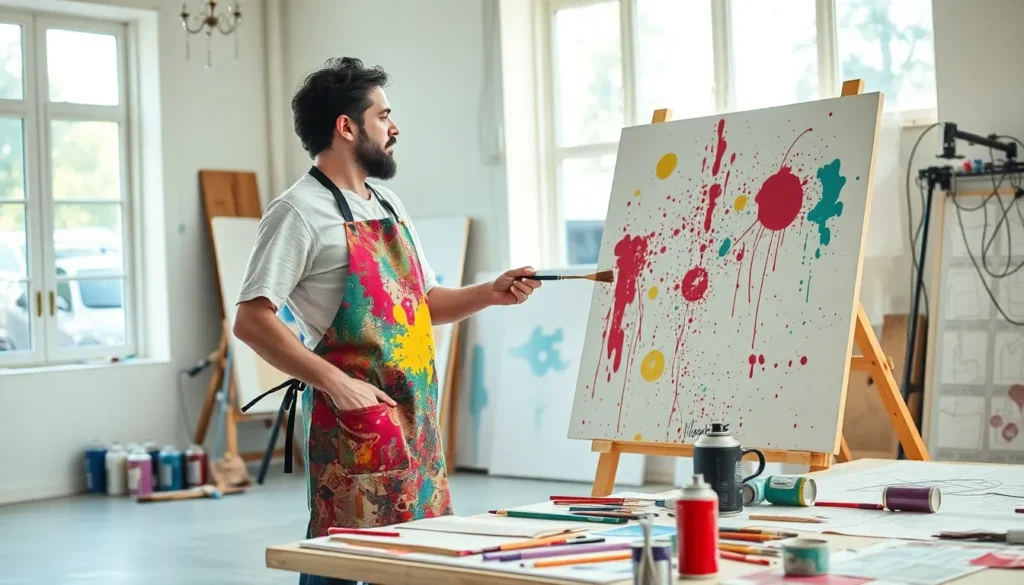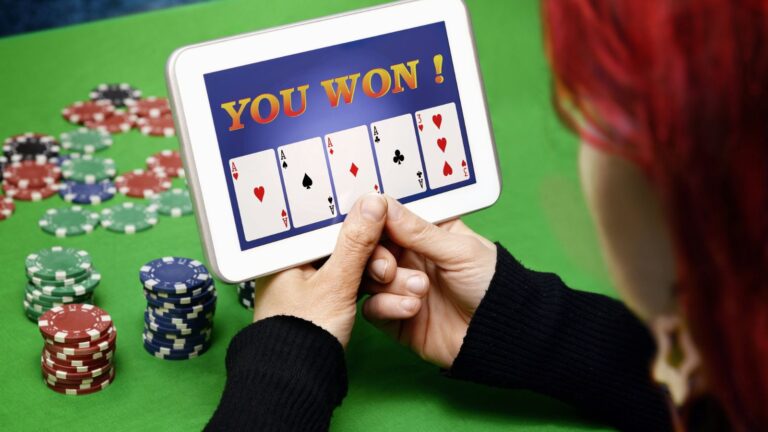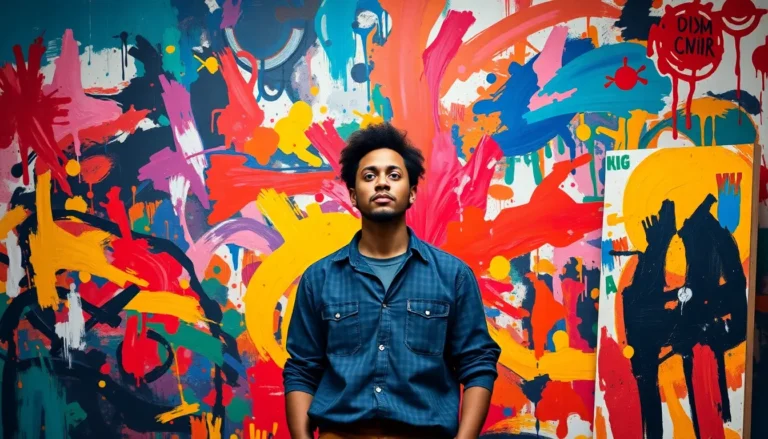In a world where creativity knows no bounds, modern art techniques are shaking things up like a toddler with a paintbrush. From splashes of color that seem to dance off the canvas to sculptures that challenge the very definition of art, these innovative methods are redefining how we express ourselves. If you thought art was just about pretty pictures hanging in stuffy galleries, think again.
Modern artists are breaking the mold, blending traditional practices with avant-garde approaches to create masterpieces that provoke thought and spark conversation. Whether it’s using unconventional materials or embracing digital mediums, the possibilities are endless. So grab your beret and prepare to dive into the vibrant world of modern art techniques, where every stroke tells a story and every piece invites a second glance.
Table of Contents
ToggleOverview of Modern Art Techniques
Modern art techniques encompass a range of innovative methods that redefine traditional artistic boundaries. Artists frequently merge classic practices with contemporary elements. Common techniques include mixed media, where various materials combine to create unique textures and visual experiences.
Digital art has gained prominence, allowing creators to use software for painting and manipulation, resulting in new forms of expression. Installation art engages viewers through immersive environments, encouraging interaction and exploration.
Performance art emphasizes the artist’s body as a medium, inviting audiences to experience art in real time. Street art, characterized by its vibrant colors and bold messages, transforms public spaces and often addresses social issues.
Furthermore, these techniques often utilize unconventional materials. Found objects, recycled items, and even everyday materials can become part of the artwork, challenging perceptions of what constitutes art.
Many contemporary artists also experiment with abstraction, prioritizing color, form, and line over realistic representation. This focus can evoke emotions and provoke thought through non-literal imagery.
In addition, collaborative projects have emerged, where multiple artists contribute to a single piece. This technique fosters community engagement and highlights diverse perspectives within the art world.
With the integration of technology, modern art continues to evolve, reflecting society’s changing values and challenges. As a result, these techniques not only showcase creativity but also invite meaningful dialogues around identity, culture, and the human experience.
Popular Modern Art Techniques

Modern art techniques showcase a variety of innovative practices that continually reshape the art world. Below are some prominent techniques.
Abstract Expressionism
Abstract Expressionism focuses on spontaneous creation and emotional intensity. Artists embrace bold colors and dynamic forms, allowing viewers to interpret meaning freely. The movement emphasizes individual expression, with renowned artists like Jackson Pollock using drip painting to capture raw emotion. Others, such as Mark Rothko, create large fields of color that evoke a deep psychological response. The style encourages experimentation and prioritizes the process over the final product.
Minimalism
Minimalism strips art down to its essential elements, highlighting simplicity and form. Artists like Donald Judd and Agnes Martin emphasize clean lines and monochromatic palettes, which encourage viewers to engage with the essence of each piece. This technique often uses repetition and geometric shapes, challenging conventional expectations of art. By eliminating extraneous details, minimalism draws attention to the materials and their intrinsic qualities. Its focus on purity fosters a calming, introspective experience.
Digital Art
Digital Art embodies creativity in the digital age, utilizing software and technology to produce striking visuals. Techniques such as digital painting, 3D modeling, and animation allow artists to push the boundaries of traditional media. Prominent figures like Beeple have gained recognition for their groundbreaking work in this field, including NFTs, which represent ownership of digital assets. This technique offers endless possibilities for experimentation and collaboration. Digital art consistently evolves, reflecting societal shifts and technological advancements.
Tools and Materials Used
Modern artists utilize a diverse array of tools and materials, enhancing their creative processes. These include both traditional and digital resources that adapt to evolving artistic practices.
Traditional Tools
Traditional tools remain vital in contemporary art creation. Brushes of various sizes help artists apply paint with precision. Palette knives enable the mixing of colors while creating texture. Many artists prefer graphite pencils for sketching initial ideas. Canvas, wood, and paper serve as the primary surfaces for painting and drawing. Oil paints, acrylics, and watercolors provide options for different effects and styles. Charcoal and pastels also add to the versatility in art production. Each tool and material contributes uniquely to the finished artwork.
Digital Tools
Digital tools have transformed the art landscape through innovative possibilities. Graphic tablets allow artists to draw directly into software, increasing accuracy. Programs like Adobe Photoshop and Illustrator offer extensive features for editing and designing. Animation software provides burgeoning artists with platforms to create moving art pieces. Many use coding and algorithms to produce generative art, merging technology with creativity. 3D modeling software enables sculptors to visualize their work before physical realization. Artists consistently explore these digital resources to expand their expressions and reach broader audiences.
Influential Modern Artists
Influential modern artists have transformed the art landscape through their groundbreaking techniques and unique perspectives. Their contributions continue to inspire emerging generations and shift traditional paradigms.
Key Contributions
Pablo Picasso’s role in the development of Cubism changed visual representation. He introduced fragmented forms, revolutionizing how subjects could be perceived. Jackson Pollock’s approach to Abstract Expressionism emphasized the act of painting itself, showcasing emotion through spontaneous brushwork. Georgia O’Keeffe’s exploration of floral forms highlighted the beauty of abstraction, influencing the direction of American modernism. Ai Weiwei combines art and activism, using modern techniques to address social issues. These artists, among others, pushed boundaries and reshaped artistic expressions.
Notable Works
“Les Demoiselles d’Avignon” exemplifies Picasso’s innovative style. This iconic piece challenged conventions and paved the way for Cubism. “No. 5, 1948,” created by Pollock, encapsulates the essence of Abstract Expressionism through energetic paint drips. O’Keeffe’s “Black Iris III” captures the intimate beauty of nature using bold colors and forms. Weiwei’s “Sunflower Seeds,” made from millions of handcrafted porcelain seeds, comments on mass production and individuality. Each work reflects the artists’ distinct approaches and their impact on modern art.
Modern art techniques are a testament to the ever-evolving nature of creativity. By blending traditional and contemporary methods artists push boundaries and challenge perceptions. The innovative use of materials and technology opens new avenues for expression and engagement.
As artists continue to explore diverse techniques and tools they invite audiences to participate in meaningful dialogues. This dynamic interplay between art and society reflects the complexities of the human experience. Embracing these modern approaches not only enriches the art world but also fosters a deeper appreciation for the creativity that shapes our cultural landscape.



